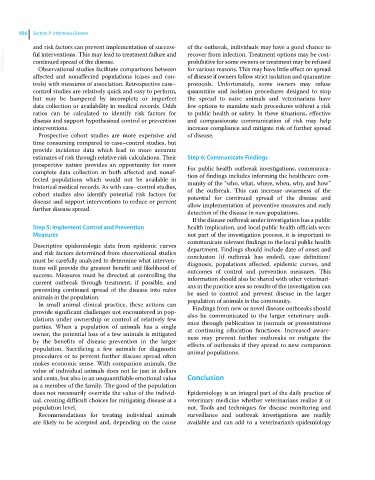Page 898 - Clinical Small Animal Internal Medicine
P. 898
836 Section 9 Infectious Disease
and risk factors can prevent implementation of success- of the outbreak, individuals may have a good chance to
VetBooks.ir ful interventions. This may lead to treatment failure and recover from infection. Treatment options may be cost‐
prohibitive for some owners or treatment may be refused
continued spread of the disease.
Observational studies facilitate comparisons between
of disease if owners follow strict isolation and quarantine
affected and nonaffected populations (cases and con- for various reasons. This may have little effect on spread
trols) with measures of association. Retrospective case– protocols. Unfortunately, some owners may refuse
control studies are relatively quick and easy to perform, quarantine and isolation procedures designed to stop
but may be hampered by incomplete or imperfect the spread to naive animals and veterinarians have
data collection or availability in medical records. Odds few options to mandate such procedures without a risk
ratios can be calculated to identify risk factors for to public health or safety. In these situations, effective
disease and support hypothesized control or prevention and compassionate communication of risk may help
interventions. increase compliance and mitigate risk of further spread
Prospective cohort studies are more expensive and of disease.
time consuming compared to case–control studies, but
provide incidence data which lead to more accurate
estimates of risk through relative risk calculations. Their Step 6: Communicate Findings
prospective nature provides an opportunity for more For public health outbreak investigations, communica-
complete data collection in both affected and nonaf- tion of findings includes informing the healthcare com-
fected populations which would not be available in munity of the “who, what, where, when, why, and how”
historical medical records. As with case–control studies, of the outbreak. This can increase awareness of the
cohort studies also identify potential risk factors for potential for continued spread of the disease and
disease and support interventions to reduce or prevent allow implementation of preventive measures and early
further disease spread.
detection of the disease in new populations.
If the disease outbreak under investigation has a public
Step 5: Implement Control and Prevention health implication, and local public health officials were
Measures not part of the investigation process, it is important to
communicate relevant findings to the local public health
Descriptive epidemiologic data from epidemic curves department. Findings should include date of onset and
and risk factors determined from observational studies conclusion (if outbreak has ended), case definition/
must be carefully analyzed to determine what interven- diagnosis, populations affected, epidemic curves, and
tions will provide the greatest benefit and likelihood of outcomes of control and prevention measures. This
success. Measures must be directed at controlling the information should also be shared with other veterinari-
current outbreak through treatment, if possible, and ans in the practice area so results of the investigation can
preventing continued spread of the disease into naive be used to control and prevent disease in the larger
animals in the population. population of animals in the community.
In small animal clinical practice, these actions can
Findings from new or novel disease outbreaks should
provide significant challenges not encountered in pop- also be communicated to the larger veterinary audi-
ulations under ownership or control of relatively few ence through publication in journals or presentations
parties. When a population of animals has a single at continuing education functions. Increased aware-
owner, the potential loss of a few animals is mitigated ness may prevent further outbreaks or mitigate the
by the benefits of disease prevention in the larger effects of outbreaks if they spread to new companion
population. Sacrificing a few animals for diagnostic animal populations.
procedures or to prevent further disease spread often
makes economic sense. With companion animals, the
value of individual animals does not lie just in dollars
and cents, but also in an unquantifiable emotional value Conclusion
as a member of the family. The good of the population
does not necessarily override the value of the individ- Epidemiology is an integral part of the daily practice of
ual, creating difficult choices for mitigating disease at a veterinary medicine whether veterinarians realize it or
population level. not. Tools and techniques for disease monitoring and
Recommendations for treating individual animals surveillance and outbreak investigations are readily
are likely to be accepted and, depending on the cause available and can add to a veterinarian’s epidemiology

